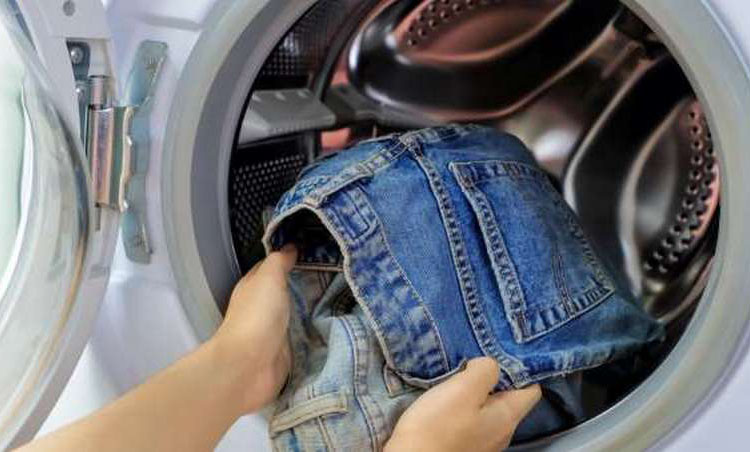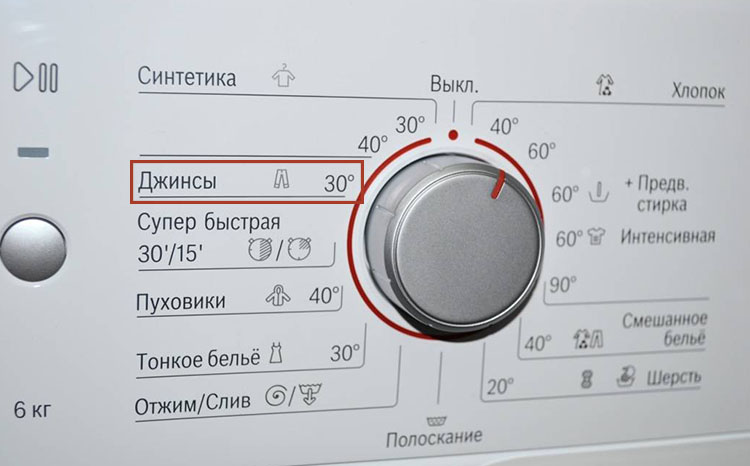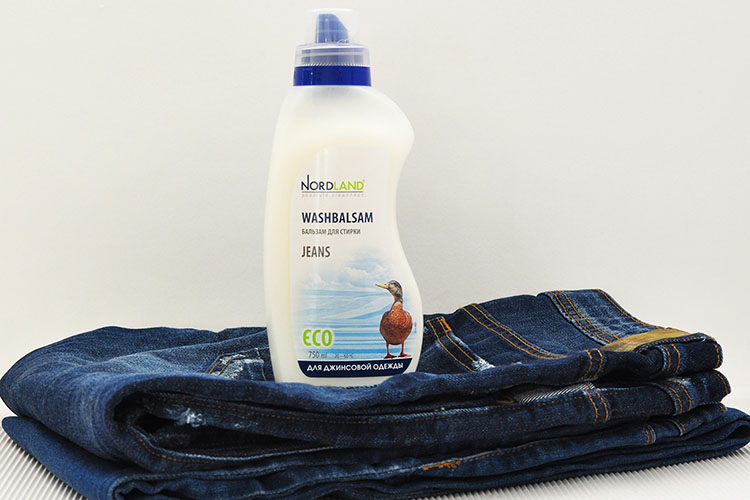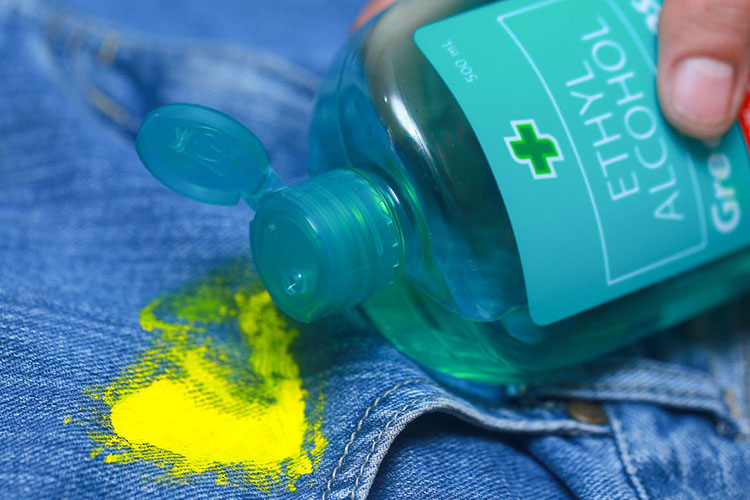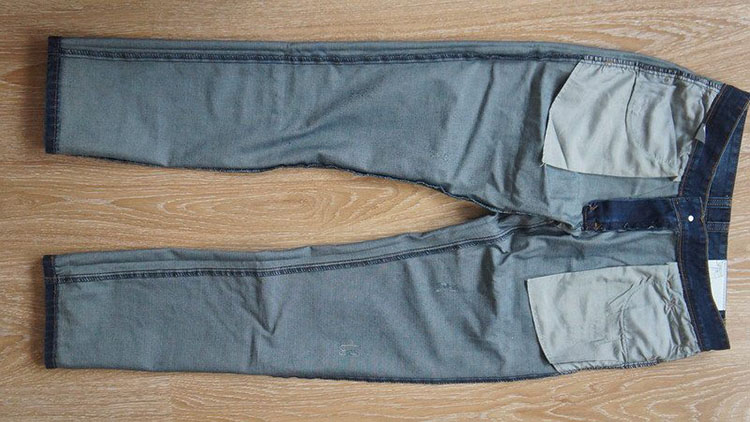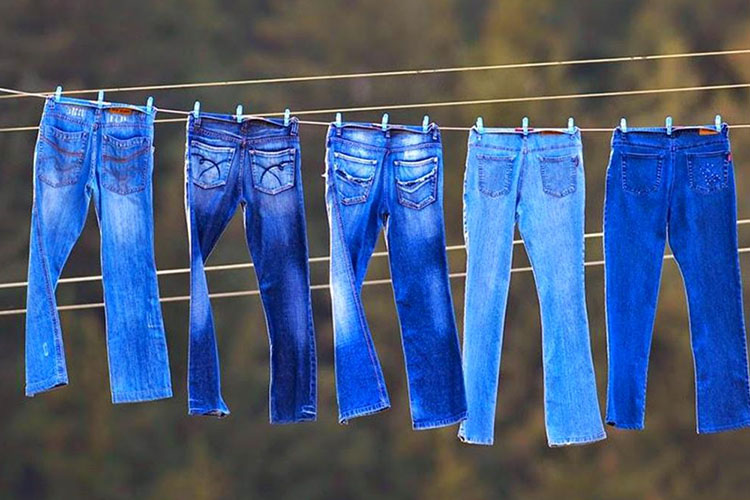How to wash jeans in a washing machine without losing color and is it allowed to wash with other linens
Care will extend the life of your favorite pair of jeans. Let's talk about the rules for washing, drying, spinning denim products.
Content
Varieties of denim fabrics
The fabric is distinguished by its composition, the technology of weaving threads, and the method of dyeing. The type of denim determines the quality and service life of the finished product.
Classification:
- Denim. Classic durable smooth canvas. Formed by weaving two-color fibers based on extra long cotton. The warp threads are blue, the weft threads are bleached, undyed. The reverse side is much lighter than the front side. The indigo dye does not penetrate into the fibers, it is deposited on the surface. The material is not picky in care, but during washing, the dye is gradually washed out, the jeans brighten.
- Broken twill, twill. Fabric with a characteristic right-hand, left-hand twill weave. It resembles a herringbone pattern on the diagonal of the canvas. Varies in thickness, thread density. Broken lines form a dense texture that will last for many years. Original Wranglers are made from twill.
- Stretch, lycra. Cotton canvas with synthetic fibers. More often, manufacturers use elastane, less often - Chinese nettle ramie. The denim fabric is stretchable, modeling the figure. Washable material. Improper care leads to shrinkage, loss of elastic properties.
- Gin. Solid blue cotton fabric. Made from cheap cotton. Major world brands use gin in the most budget models. Requires delicate handling.
- Shambry. Lightweight melange cotton fabric. The threads are intertwined without displacement, at a right angle. The basis of concise, comfortable everyday wear: shirts, tunics, dresses.
- Eikru (ecru). Raw cotton, linen material from undyed yarn. The color depends on the type, quality of the fiber, manufacturing technology.
It is customary to distinguish between sanforized and raw denim. Processing according to the sanforization technology reduces shrinkage, shedding due to the maximum washing out of the dye.
Rigid denim without factory processing during the first care intensively loses indigo, shrinks in size.
What temperature to wash jeans
Jeans require timely cleaning. Send the item to the washing machine as needed when it needs to be restored to its proper look and hygienic condition.
Care cannot be parted. On average, you can use the washing machine once every 1-2 weeks or less.
When choosing a temperature, consider the recommendations on the label. The information tag contains the rules for washing, drying, ironing. Products are sewn from different materials, care for each pair is individual.
Automatic washing modes:
- "Delicate".
- "Berezhnaya".
- "Manual".
- "Quickly 30".
- "Jeans".
Avoid the hot modes of automatic washing machines. High temperature will ruin the thing, lead to deformation, shrinkage, stretching. The color will become lighter, the decor will be damaged.
Do not use high speed programs. Intensive scrolling leads to washing out of indigo, the formation of creases. The optimal number of revolutions is 400-600. The highest permissible drum rotation speed is 800.
Use alternate care methods between automatic washes.
Ways to freshen up jeans:
- Hang in fresh air for 12 hours.
- Put in a bag, put in the freezer for 3-5 hours.
- Leave under hot steam in the bath for 1-2 hours.
Remove small dirt with a damp sponge.
Which tool to choose
Use detergents without phosphates, enzymes, bleaches. Aggressive substances wash out the color, lead to the destruction of fabric fibers.
Detergents for washing jeans:
- Household free-flowing laundry detergent is mild and does not contain bleach.
- Liquid washing gels.
- Powders with the addition of laundry soap.
- Denim specials.
- Oxygen products - for colored, mixed materials.
- Color stabilizers - for dark-colored.
- Delicate means - for things with applications, embroidery, leather, lace inserts.
The product packaging indicates the dosage that should be observed. Detergent requires thorough rinsing.
Stain removal and whitening
For pre-treatment of complex stains, use cleaners for natural fabrics: powders, gels, laundry soap and improvised means.
Soak
Exposure of the product in the cleaning solution will remove most of the dirt. Dissolving stains with water and detergents will simplify the washing process.
Technology:
- Fill the container with water t 40 ° C.
- Prepare a solution. Dilute the detergent according to the instructions.
- Turn the product inside out.
- Submerge in water with solution. If a thing pops up, put oppression.
Leave the jeans for 3 hours, send them to the drum of the washing machine.
Soak after purchase
A new thing requires pre-treatment.
With sanforized denim, soaking will remove excess materials after production, help set the indigo dye, and reduce dye loss due to friction.
Raw denim is soaked to pre-shrink the fabric.
Technology:
- Fill up the bath. For raw denim, use water at 40°C, for sanforized denim, use 20-30°C.
- Add 1 cup of vinegar and sea salt.
- Turn the thing inside out, immerse in water. Put down the load.
Leave the denim for 1-2 hours. Rinse, remove the product, do not wring out the water.
Dry by hanging on a rope.
Washing and stain removal
Difficult stains require preliminary manual cleaning. For washing use a soft brush, sponge, cotton pads, paper towels.
Washing algorithm with preliminary stain removal:
- Examine the label.
- Choose a laundry detergent.
- Review dosage information.
- Select a washing mode.
- Shake off the dust with a brush, pre-treat the stain by hand.
- Wash.
Grease, oil stains
Sprinkle a fresh greasy stain with tooth powder, salt or starch, leave for 10 minutes. Carefully remove the powder with a paper towel.
For stubborn stains, use dishwashing detergent. Unlike other stains, wash at t no higher than 30°C. This will prevent the fixation of fat, oil.
coffee, food
Prepare an emulsion to remove traces of coffee drinks: 2-3 drops of alcohol, a little warm water, egg yolk. Apply the mixture on the stain for 10 minutes, rinse with a sponge.
Remove food stains with carbonated water and salt (250 ml/10 g). Apply the solution by rubbing with a clean cotton pad.You can carry out the treatment with household washing powder, stain remover, laundry soap.
wine stains
Blot a fresh stain with a white dry cloth, remove excess liquid.
Turn your jeans inside out and rinse with plenty of cold water. Apply detergent on the front side. Leave for 5-10 minutes, wash.
paint stains
Wet water-based paint with warm water and dish detergent. Oily - with a solvent, medical alcohol or nail polish remover.
Leave the soaked stain for 20-30 minutes, wash the item in the machine.
Stains from grass, leaves
Let the stain dry first, then scrape off the dirt. Once the pieces of dirt are removed, apply a household cleaner or a thick layer of laundry soap shavings. Rub carefully.
After 30-40 min. wash at a temperature acceptable for the product.
Recommendations:
- Use a stain remover - apply the solution pointwise so as not to damage the fabric around. The exposure time is indicated on the package.
- Clean light-colored jeans with hydrogen peroxide. Spread generously on the stain, leave for 20 minutes.
If a stain from street dirt has formed on the steam, you can not immediately wipe it off with water. An ugly light spot will appear on the fabric.
Wait until the dirt dries, gently, without extra effort, wipe off with a brush. Turn the product inside out, wash with warm water without detergents, send to the laundry.
blood stains
Blood stains are afraid of cold water.
Staining technology:
- Fresh pollution. Blot the area with a cloth, soak for 20-30 minutes. send it to an automatic washing machine.
- Outdated.Clean the stain with dishwashing gel, salt, baking soda, or use a solution of cold water and laundry detergent. Soak for 10-15 min. Remove from water, blot the blood as far as possible and wash.
Is it allowed to wash with other linen
It is recommended to wash dark and light denim separately from all other things. Loading with jeans of the same color, fabrics similar in texture is acceptable.
Do not mix with delicate materials.
To prevent fading, reduce friction, take no more than 3-4 items at a time.
Preparing for washing
Sorting, sort things by color. For heavily soiled jeans, carry out the soak or wash operations.
Preparation algorithm:
- Fasten zippers, bolts.
- Check pockets, remove all items. Remove belts, suspenders. This will protect the car from damage. The thing will remain intact, without unpredictable stains.
- Turn inside out. This will help protect the product from damage, fading when machine washed. Straighten the thing.
- Products with stripes, appliqués, prints, rhinestones, beads, place in a bag.
Load into the drum, set the wash cycle in cool water.
Is fabric softener necessary?
The conditioner will preserve the color, add fragrance, and make the denim easier to iron. Use a care product for classic denim without impregnation.
Do not add it when washing jeans with elastane. The rinse aid will clog the fibers - the product will lose its shape and size.
Application rules:
- Strict adherence to dosage. Too much rinse aid will ruin the fabric. Jeans will become stiff, get dirty quickly, and lose their breathability.
- The concentrate is pre-diluted with water according to the instructions.
- The agent is added to a special compartment of the washing machine, and not to the powder.
Spin and dry
Turn off the spin function in the automatic washing machine. The mode will lead to the appearance of unnatural, ugly brightened creases.
After washing, hang the product so that all the water is on the glass. Do not wring by hand, do not twist.
Drying:
- Do not dry in the machine. Automatic drying is the worst enemy of jeans. Aggressive temperature exposure leads to loss of color, shrinkage, damage. Do not dry over open heat sources.
- Hang the item outdoors in a place without direct sunlight. Hang on a clothesline, hanger or dryer. Straighten creases, bumps, turn pockets inside out to dry faster.
- Do not bend the product, hang it by the belt - the densest part. There will be no traces of clothespins here. Jeans will dry evenly, without wrinkles.
- Do not leave jeans in the drum of the machine. Moisture will cause rust from buttons and other metal parts.
Improper care is the cause of premature wear, shedding, shrinkage, and deformation of jeans. Textiles lose their original color, strength.
Follow simple recommendations and the thing will last a long time.
Useful video
We offer you to watch a short video clip from which you will learn how to wash jeans in a washing machine:



